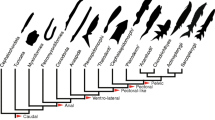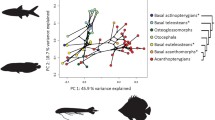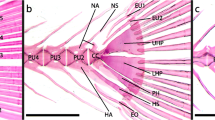Abstract
Actinopterygians demonstrate high levels of morphological disparity, especially in the variation of fin positions, sizes and shapes. One hypothesis to explain the diversity of fin morphologies is that it is facilitated by a modular organization. According to this hypothesis, fin modules would be quasi-independent during ontogeny or evolution, facilitating their evolvability. We investigated variational modularity of fins in two cyprinid species, the zebrafish (Danio rerio) and the Northern redbelly dace (Chrosomus eos), to determine which subsets of fins are quasi-independent and which are most highly integrated in positioning. Hypotheses of modularity were evaluated using a combination of methods suitable for analyses of landmarks. The hypothesis that the dorsal and anal fins belong to a posterior trunk and tail module is strongly supported, a finding that can be explained by the use of subcarangiform locomotion in these two species. There is also some support for the hypothesis that the paired fins and head region each constitute variational modules. The support for fin variational modules is weaker than expected considering the wealth of developmental evidence supporting fin modularity. This might be related to a dissociation of the fin positioning modules during actinopterygian evolution, a process that had already been suggested for the dorsal and anal fins. Alternatively, the fin modules inferred from developmental data might not directly translate into variational modules: variational modules can incorporate the signals from numerous partially overlapping developmental processes so that one to one correspondence between developmental and variational modules is not always expected.



Similar content being viewed by others
References
Abe, G., Ide, H., & Tamura, K. (2007). Function of FGF signaling in the developmental process of the median fin fold in zebrafish. Developmental Biology, 304(1), 355–366.
Ackermann, R. R., & Cheverud, J. M. (2000). Phenotypic covariance structure in tamarins (genus Saguinus): A comparison of variation patterns using matrix correlation and common principal component analysis. American Journal of Physical Anthropology, 111(4), 489–501.
Adams, D. C., & Otarola-Castillo, E. (2013). geomorph: An R package for the collection and analysis of geometric morphometric shape data. Methods in Ecology and Evolution, 4(4), 393–399.
Adams, D. C., Rohlf, F. J., & Slice, D. E. (2013). A field comes of age: Geometric morphometrics in the 21st century. Hystrix, Italian Journal of Mammalogy, 24(1), 7–14.
Akaike, H. (1974). A new look at the statistical model identification. IEEE Transactions on Automatic Control, 19(6), 716–723.
Balfour, F. M. (1876). The development of elasmobranch fishes. The Journal of Anatomy and Physiology, 11(1), 128–172.
Balfour, F. M. (1878). A monograph on the development of elasmobranch fishes (p. 295). London: MacMillan.
Balfour, F. M. (1881). On the development of the skeleton of the paired fins of Elasmobranchii, considered in relation to its bearings on the nature of the limbs of the Vertebrata. Proceedings of the Zoological Society of London 1881 (pp. 656–671).
Bemis, W. E., & Grande, L. (1999). Development of the median fins of the North American paddlefish (Polyodon spathula), and a reevaluation of the lateral fin-fold hypothesis. In G. Arratia & H.-P. Schultze (Eds.), Mesozoic fishes 2—Systematics and fossil record (pp. 41–68). München: Verlag Dr. Friedrich Pfeil.
Bolker, J. A. (2000). Modularity in development and why it matters to evo-devo. American Zoologist, 40(5), 770–776.
Bonner, J. T. (1988). The evolution of complexity by means of natural selection (p. 260). Princeton, NJ: Princeton University Press.
Bookstein, F. L. (1997). Landmark methods for forms without landmarks: Morphometrics of group differences in outline shape. Medical Image Analysis, 1(3), 225–243.
Chernoff, B., & Magwene, P. M. (1999). Afterword—Morphological integration: Forty years later. In E. C. Olson & C. G. Miller (Eds.), Morphological integration (pp. 319–353). Chicago, IL: The University of Chicago Press.
Cheverud, J. M. (1982). Phenotypic, genetic, and environmental morphological integration in the cranium. Evolution, 36(3), 499–516.
Cheverud, J. M. (1996). Developmental integration and the evolution of pleiotropy. American Zoologist, 36(1), 44–50.
Cheverud, J. M., Hartman, S. E., Richtsmeier, J. T., & Atchley, W. R. (1991). A quantitative genetic analysis of localized morphology in mandibles of inbred mice using finite element scaling analysis. Journal of Craniofacial Genetics and Developmental Biology, 1991(11), 122–137.
Cheverud, J. M., Wagner, G. P., & Dow, M. M. (1989). Methods for the comparative analysis of variation patterns. Systematic Zoology, 38(3), 201–213.
Cloutier, R. (2010). The fossil record of fish ontogenies: Insights into developmental patterns and processes. Seminars in Cell & Developmental Biology, 21(4), 400–413.
Coates, M. I. (1993). Hox genes, fin folds and symmetry. Nature, 364, 195–196.
Coates, M. I. (1994). The origin of vertebrate limbs. In M. Akam, P. Holland, P. Ingham & G. Wray (Eds.), The evolution of developmental mechanisms (pp. 169–180). Cambridge, UK: The Company of Biologists Limited.
Coates, M. I., & Cohn, M. J. (1998). Fins, limbs, and tails: Outgrowths and axial patterning in vertebrate evolution. BioEssays, 20(5), 371–381.
Coates, M. I., Jeffery, J. E., & Ruta, M. (2002). Fins to limbs: What the fossils say. Evolution & Development, 4(5), 390–401.
Crotwell, P. L., Clark, T. G., & Mabee, P. M. (2001). Gdf5 is expressed in the developing skeleton of median fins of late-stage zebrafish, Danio rerio. Development Genes and Evolution, 211(11), 555–558.
Crotwell, P. L., & Mabee, P. M. (2007). Gene expression patterns underlying proximal-distal skeletal segmentation in late-stage zebrafish, Danio rerio. Developmental Dynamics, 236(11), 3111–3128.
Crotwell, P. L., Sommervold, A. R., & Mabee, P. M. (2004). Expression of bmp2a and bmp2b in late-stage zebrafish median fin development. Gene Expression Patterns, 5(2), 291–296.
Edwards, D. (1995). Introduction to graphical modelling (p. 274). New York, NY: Springer.
Edwards, D. (2000). Introduction to graphical modelling (2nd ed., p. 352). New York, NY: Springer.
Edwards, D. (2004). MIM—A program for graphical modelling. Version 3.2.0.7.
Engeszer, R. E., Patterson, L. B., Rao, A. A., & Parichy, D. M. (2007). Zebrafish in the wild: A review of natural history and new notes from the field. Zebrafish, 4(1), 21–40.
Escoufier, Y. (1973). Le traitement des variables vectorielles. Biometrics, 29(4), 751–760.
Freitas, R., Gómez-Skarmeta, J. L., & Rodrigues, P. N. (2014). New frontiers in the evolution of fin development. Journal of Experimental Zoology Part B-Molecular and Developmental Evolution, 322B(7), 540–552.
Freitas, R., Zhang, G. J., & Cohn, M. J. (2006). Evidence that mechanisms of fin development evolved in the midline of early vertebrates. Nature, 442(7106), 1033–1037.
Freitas, R., Zhang, G. J., & Cohn, M. J. (2007). Biphasic Hoxd gene expression in shark paired fins reveals an ancient origin of the distal limb domain. PLoS ONE, 2(8), e754.
Goodrich, E. S. (1906). Notes on the development, structure, and origin of the median and paired fins of fish. Quarterly Journal of Microscopical Science, 50, 333–376.
Green, W. D. K. (1996). The thin-plate spline and images with curving features. In K. V. Mardia, C. A. Gill & I. L. Dryden (Eds.), Proceedings in image fusion and shape variability techniques (pp. 79–87). Leeds, UK: Leeds University Press.
Grünbaum, T., Cloutier, R., & Vincent, B. (2012). Dynamic skeletogenesis in fishes: Insight of exercise training on developmental plasticity. Developmental Dynamics, 241(10), 1507–1524.
Hall, B. K. (2010). Charles Darwin, embryology, evolution and skeletal plasticity. Journal of Applied Ichthyology, 26(2), 148–151.
Hallgrímsson, B., Jamniczky, H., Young, N. M., Rolian, C., Parsons, T. E., Boughner, J. C., & Marcucio, R. S. (2009). Deciphering the palimpsest: Studying the relationship between morphological integration and phenotypic covariation. Evolutionary Biology, 36(4), 355–376.
Hallgrímsson, B., Willmore, K., & Hall, B. K. (2002). Canalization, developmental stability, and morphological integration in primate limbs. Yearbook of Physical Anthropology, 45, 131–158.
Hanke, G. F., & Wilson, M. V. H. (2006). Anatomy of the Early Devonian acanthodian Brochoadmones milesi based on nearly complete body fossils, with comments on the evolution and development of paired fins. Journal of Vertebrate Paleontology, 26(3), 526–537.
Hansen, T. F. (2003). Is modularity necessary for evolvability? Remarks on the relationship between pleiotropy and evolvability. Biosystems, 69(2–3), 83–94.
Hansen, T. F., Armbruster, W. S., Carlson, M. L., & Pelabon, C. (2003). Evolvability and genetic constraint in Dalechampia blossoms: Genetic correlations and conditional evolvability. Journal of Experimental Zoology Part B-Molecular and Developmental Evolution, 296B(1), 23–39.
He, S. P., Mayden, R. L., Wang, X. Z., Wang, W., Tang, K. L., Chen, W. J., & Chen, Y. Y. (2008). Molecular phylogenetics of the family Cyprinidae (Actinopterygii: Cypriniformes) as evidenced by sequence variation in the first intron of S7 ribosomal protein-coding gene: Further evidence from a nuclear gene of the systematic chaos in the family. Molecular Phylogenetics and Evolution, 46(3), 818–829.
Klingenberg, C. P. (2008). Morphological integration and developmental modularity. Annual Review of Ecology Evolution and Systematics, 39, 115–132.
Klingenberg, C. P. (2009). Morphometric integration and modularity in configurations of landmarks: Tools for evaluating a priori hypotheses. Evolution & Development, 11(4), 405–421.
Klingenberg, C. P., Mebus, K., & Auffray, J. C. (2003). Developmental integration in a complex morphological structure: How distinct are the modules in the mouse mandible? Evolution & Development, 5(5), 522–531.
Kuratani, S. (2009). Modularity, comparative embryology and evo-devo: Developmental dissection of evolving body plans. Developmental Biology, 332(1), 61–69.
Lauder, G. V., & Drucker, E. G. (2004). Morphology and experimental hydrodynamics of fish fin control surfaces. IEEE Journal of Oceanic Engineering, 29(3), 556–571.
Lauder, G. V., & Liem, K. F. (1983). The evolution and interrelationships of the actinopterygian fishes. Bulletin of the Museum of Comparative Zoology, 150(3), 95–197.
Lauritzen, S. L. (1996). Graphical models (p. 298). Oxford: Clarendon Press.
Lindsey, C. C. (1978). Form, function, and locomotory habits in fish. In W. S. Hoar & D. J. Randall (Eds.), Fish physiology: Locomotion (Vol. VII, pp. 1–100). New York, NY: Academic Press.
Mabee, P. M., Crotwell, P. L., Bird, N. C., & Burke, A. C. (2002). Evolution of median fin modules in the axial skeleton of fishes. Journal of Experimental Zoology (Molecular and Developmental Evolution), 294(2), 77–90.
Magwene, P. M. (2001). New tools for studying integration and modularity. Evolution, 55(9), 1734–1745.
Magwene, P. M. (2009). Statistical methods for studying modularity: A reply to Mitteroecker and Bookstein. Systematic Biology, 58(1), 146–149.
Mantel, N. (1967). The detection of disease clustering and a generalized regression approach. Cancer Research, 27(2), 209–220.
Marchetti, G. M., Drton, M., & Sadeghi, K. (2014). ggm: A package for graphical Markov models. Version 2.0.
Marquez, E. J. (2008). A statistical framework for testing modularity in multidimensional data. Evolution, 62(10), 2688–2708.
Marquez, E. J. (2014). Mint: Modularity and integration analysis tool for morphometric data. Version, 1, 61.
McClure, M. M., McIntyre, P. B., & McCune, A. R. (2006). Notes on the natural diet and habitat of eight danionin fishes, including the zebrafish Danio rerio. Journal of Fish Biology, 69(2), 553–570.
Mivart, S. G. (1879). Notes on the fins of elasmobranchs, with considerations on the nature and homologues of vertebrate limbs. Transactions of the Zoological Society of London, 10, 439–484.
Monteiro, L. R., Bonato, V., & dos Reis, S. F. (2005). Evolutionary integration and morphological diversification in complex morphological structures: Mandible shape divergence in spiny rats (Rodentia, Echimyidae). Evolution & Development, 7(5), 429–439.
Nelson, J. S. (2006). Fishes of the world (4th ed., p. 601). Hoboken, NJ: Wiley.
Oksanen, J., Blanchet, F. G., Kindt, R., Legendre, P., Minchin, P. R., O’hara, R. B., et al. (2013). vegan: Community ecology package. Version 2.0-10.
Olson, E. C., & Miller, R. L. (1958). Morphological integration (p. 317). Chicago, IL: The University of Chicago Press.
Parsons, K. J., Marquez, E., & Albertson, R. C. (2012). Constraint and opportunity: The genetic basis and evolution of modularity in the cichlid mandible. American Naturalist, 179(1), 64–78.
Pavlicev, M., & Hansen, T. F. (2011). Genotype–phenotype maps maximizing evolvability: Modularity revisited. Evolutionary Biology, 38(4), 371–389.
Phillips, G. L. (1969). Morphology and variation of the American cyprinid fishes Chrosomus erythrogaster and Chrosomus eos. Copeia, 1969(3), 501–509.
Plaut, I., & Gordon, M. S. (1994). Swimming metabolism of wild-type and cloned zebrafish Brachydanio rerio. Journal of Experimental Biology, 194(1), 209–223.
R Core Team. (2014). R: A language and environment for statistical computing. Version 3.0.3. Vienna, Austria: R Foundation for Statistical Computing.
Raff, R. A. (1996). The shape of life: Genes, development, and the evolution of animal form (p. 544). Chicago, IL: The University of Chicago Press.
Richtsmeier, J. T., Lele, S. R., & Cole, T. M, I. I. I. (2005). Landmark morphometrics and the analysis of variation. In B. Hallgrímsson & B. K. Hall (Eds.), Variation: A central concept in biology (pp. 49–69). Amsterdam: Elsevier Academic Press.
Rohlf, F. J. (2013a). tps Utiliy Program. Version 1.58. Stony Brook University, NY.
Rohlf, F. J. (2013b). tpsDig. Version 2.17. Stony Brook University, NY.
Rohlf, F. J., & Slice, D. (1990). Extensions of the Procrustes method for the optimal superimposition of landmarks. Systematic Zoology, 39(1), 40–59.
Rosen, D. E. (1982). Teleostean interrelationships, morphological function and evolutionary inference. American Zoologist, 22(2), 261–273.
Ruvinsky, I., & Gibson-Brown, J. J. (2000). Genetic and developmental bases of serial homology in vertebrate limb evolution. Development, 127(24), 5233–5244.
Sampson, P. D., Bookstein, F. L., Sheehan, H., & Bolson, E. L. (1996). Eigenshape analysis of left ventricular outlines from contrast ventriculograms. In L. F. Marcus, M. Corti, A. Loy, G. J. P. Naylor, & D. E. Slice (Eds.), Advances in morphometrics (pp. 131–152). New York: Plenum Press.
Schlosser, G., & Wagner, G. P. (2004). Introduction: The modularity concept in developmental and evolutionary biology. In G. Schlosser & G. P. Wagner (Eds.), Modularity in development and evolution (pp. 1–11). Chicago, IL: The University of Chicago Press.
Scott, W. B., & Crossman, E. J. (1973). Freshwater fishes of Canada. Bulletin of the Fisheries Research Board of Canada, 184, 1–966.
Sfakiotakis, M., Lane, D. M., & Davies, J. B. C. (1999). Review of fish swimming modes for aquatic locomotion. IEEE Journal of Oceanic Engineering, 24(2), 237–252.
Shubin, N. H., & Davis, M. C. (2004). Modularity in the evolution of vertebrate appendages. In G. Schlosser & G. P. Wagner (Eds.), Modularity in development and evolution (pp. 429–440). Chicago, IL: The University of Chicago Press.
Shubin, N., Tabin, C., & Carroll, S. (1997). Fossils, genes and the evolution of animal limbs. Nature, 388(6643), 639–648.
Stewart, T. A., Smith, W. L., & Coates, M. I. (2014). The origins of adipose fins: An analysis of homoplasy and the serial homology of vertebrate appendages. Proceedings of the Royal Society B-Biological Sciences, 281(1781), 20133120.
Tanaka, M., Munsterberg, A., Anderson, W. G., Prescott, A. R., Hazon, N., & Tickle, C. (2002). Fin development in a cartilaginous fish and the origin of vertebrate limbs. Nature, 416(6880), 527–531.
Tanaka, M., & Onimaru, K. (2012). Acquisition of the paired fins: A view from the sequential evolution of the lateral plate mesoderm. Evolution & Development, 14(5), 412–420.
Thacher, J. K. (1877). Median and paired fins, a contribution to the history of vertebrate limbs. Transactions of the Connecticut Academy of Arts and Science, 3, 281–308.
von Dassow, G., & Munro, E. (1999). Modularity in animal development and evolution: Elements of a conceptual framework for evo-devo. Journal of Experimental Zoology, 285(4), 307–325.
Wagner, G. P. (1996). Homologues, natural kinds and the evolution of modularity. American Zoologist, 36(1), 36–43.
Wagner, G. P., & Altenberg, L. (1996). Perspective: Complex adaptations and the evolution of evolvability. Evolution, 50(3), 967–976.
Wagner, G. P., & Mezey, J. G. (2004). The role of genetic architecture constraints in the origin of variational modularity. In G. Schlosser & G. P. Wagner (Eds.), Modularity in Development and Evolution (pp. 338–358). Chicago, IL: The University of Chicago Press.
Wagner, G. P., Pavlicev, M., & Cheverud, J. M. (2007). The road to modularity. Nature Reviews Genetics, 8(12), 921–931.
Webb, P. W. (1975). Hydrodynamics and energetics of fish propulsion. Bulletin of the Fisheries Research Board of Canada, 190, 1–158.
Webb, P. W. (1982). Locomotor patterns in the evolution of actinopterygian fishes. American Zoologist, 22(2), 329–342.
Webb, P. W. (1984). Body form, locomotion and foraging in aquatic vertebrates. American Zoologist, 24(1), 107–120.
Whittaker, J. (1990). Graphical models in applied mathematical multivariate statistics (p. 462). New York, NY: Wiley.
Yamanoue, Y., Setiamarga, D. H. E., & Matsuura, K. (2010). Pelvic fins in teleosts: Structure, function and evolution. Journal of Fish Biology, 77(6), 1173–1208.
Young, N. M., & Hallgrímsson, B. (2005). Serial homology and the evolution of mammalian limb covariation structure. Evolution, 59(12), 2691–2704.
Young, N. M., Wagner, G. P., & Hallgrímsson, B. (2010). Development and the evolvability of human limbs. Proceedings of the National Academy of Sciences of the United States of America, 107(8), 3400–3405.
Zelditch, M. L. (1987). Evaluating models of developmental integration in the laboratory rat using confirmatory factor analysis. Systematic Zoology, 36(4), 368–380.
Zelditch, M. L., Swiderski, D. L., & Sheets, H. D. (2012). Geometric morphometrics for biologists: A primer (2nd ed., p. 478). London: Elsevier Academic Press.
Zelditch, M. L., Wood, A. R., Bonett, R. M., & Swiderski, D. L. (2008). Modularity of the rodent mandible: Integrating bones, muscles, and teeth. Evolution & Development, 10(6), 756–768.
Zelditch, M. L., Wood, A. R., & Swiderski, D. L. (2009). Building developmental integration into functional systems: Function-induced integration of mandibular shape. Evolutionary Biology, 36(1), 71–87.
Acknowledgments
We would like to thank V. Roy for his help in managing the order of the D. rerio specimens and maintenance of the aquaria. We also thank an anonymous reviewer for his suggestions. This work was supported by the Natural Sciences and Engineering Research Council of Canada (PGS-D 155707997 to O.L.; NSERC Discovery Grant 238612 to R.C.).
Conflict of interest
The authors declare that they have no conflict of interest.
Ethical standard
Experiments complied with the current laws in Canada. Handling of animals complied with the guidelines of the Canadian Council of Animal Care.
Author information
Authors and Affiliations
Corresponding author
Rights and permissions
About this article
Cite this article
Larouche, O., Cloutier, R. & Zelditch, M.L. Head, Body and Fins: Patterns of Morphological Integration and Modularity in Fishes. Evol Biol 42, 296–311 (2015). https://doi.org/10.1007/s11692-015-9324-9
Received:
Accepted:
Published:
Issue Date:
DOI: https://doi.org/10.1007/s11692-015-9324-9




